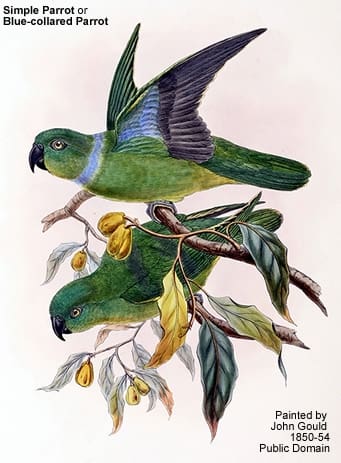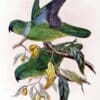Blue-collared Parrot
Also known as:
Lilac-collared Parrot
Also known as:
Lilac-collared Parrot

Geoffroyus

simplex
Size:
22 cm (8.5 in)
Weight:
195 g (6.8 oz)
Subspecies including nominate:
two: G.s. simplex, G.s. buergersi
Colour Adult:
G.s. simplex: Male-mostly green in colour; collar of grey/blue around neck; bronze/brown mark on inner median wing coverts; dark blue underwing coverts. Beak grey/black. Eye cream/white. Female-blue collar around neck absent.
G.s. buergersi: Male-blue/purple collar on neck broader; more purple/blue underwing coverts. Female-underwing coverts as in male.
Colour Juvenile:
G.s. simplex: As in adult female.
G.s. buergersi: As in adult female.
Call:
Calls in flight are distinctive, a loud rolling series of notes repeated continuously; harsh sounding from close by but musical from a distance.
More Information:
Content Sources:
CITES
BirdLife International
A Guide to Parrots of the World, Juniper and Parr, 1998
Cornell Lab of Ornithology/Birds of the World
Parrots of the World, Forshaw, 2006. 2010 edition
Lexicon of Parrots, Thomas Arndt.
Captive Status:
Uncommon
Longevity:
—
Housing:
Aviary with shelter 2.5 x 1 x 2 m (8.2 x 3.3 x 6.5 ft).
Diet:
Fruits such as: banana, apple, pear, oranges; small seed mix such as: millet, oats, buckwheat, canary and some sunflower, sprouted or not; lory cereal of honey, pollen, brewer’s yeast, oat and multigrain flakes; vitamin and mineral supplements.
Enrichment:
—
Nest Box Size:
—
Clutch Size:
3 young recorded.
Fledging Age:
—
Hatch Weight:
—
Peak Weight:
—
Weaning Weight:
—
World Population:
Unknown, decreasing.
IUCN Red List Status:
Least Concern
CITES Listing:
Appendix II
Threat Summary:
Not globally threatened. Generally rather scarce to fairly common and extremely shy. This species is considered to have a high dependency on forests, and tree cover is estimated to have declined by 2.5% within its range over three generations. It is therefore tentatively suspected that this forest loss may have led to a 1-19% decline in the species’ population size over the same time frame.
Range:
G.s. simplex: Arfak and Tamrau Mountains on Vogelkop Peninsula, West Papua.
G.s. buergersi: Mountains of New Guinea, except Vogelkop Peninsula.
Habitat:
Found from 600-2000 m (1968-6560 ft) in humid hill and middle montane forest, along forest edge and in secondary growth forest.
Wild Diet:
Feeds on seeds of Castanopsis and Lithocarpus oaks in particular, and small seeds. Seen at flowering trees presumably for nectar and blossoms.
Ecology and Behaviour:
Shy and difficult to spot in dense foliage. May be seen in large flocks of up to 200 birds, flying overhead. Birds feed quietly in the canopy.
Clutch and Egg Size:
3 young recorded.
Breeding Season:
October-January. Nest is in tree cavity.
Related Links:
—

